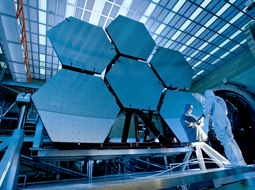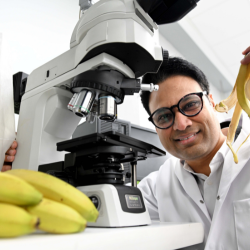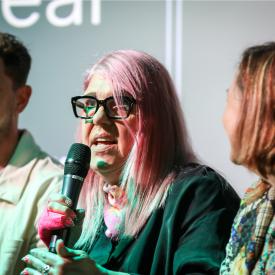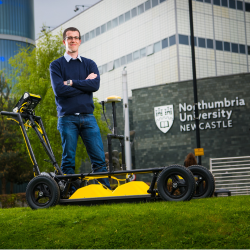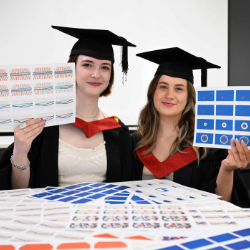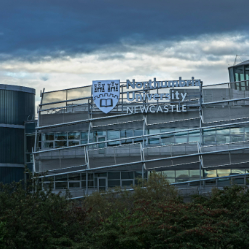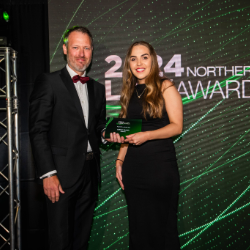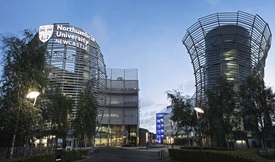The world is facing an
unprecedented energy challenge. While many countries around the world have
committed to net-zero carbon emissions by 2050, we expect global energy for
demand to double from today’s requirements within the same
timescale. There is, therefore, an urgent need for sustainable solutions
and technologies.
To help meet this need, Energy Futures - a diverse and inclusive community of over 50
academics from across various departments at Northumbria University – is
driving forward innovative research-driven approaches to create a cleaner
energy future for all. Energy Futures encompasses high-quality research
spanning photovoltaics, thin film materials, batteries, materials
characterisation, electrical power engineering, heat, sustainable design, and
the built environment.
As part of our work to shine a light on climate-related
research from Northumbria in the run-up to COP26 we asked Dr Lucy Whalley, Vice-Chancellor’s Fellow from Northumbria's Department of Mathematics, Physics and Electrical Engineering, to
tell us about her research in developing new energy technologies.
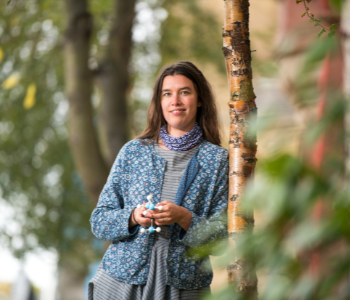
While many people use
green energy sources to power their homes these sources can often be
intermittent due to the weather, which means they might not always deliver
electricity or heating when needed. But what if there were more efficient ways
to generate and store this renewable energy?
Dr Lucy Whalley is leading
research into identifying materials which will improve the light-to-electricity
efficiency of solar cells, and increase the amount of energy that can be stored
by rechargeable batteries.
Tell us
about your area of research
I specialise in
computational materials science which is a combination of physics, chemistry
and software engineering. I use techniques from these fields, alongside
high-performance-computing (supercomputers) to investigate why certain
materials perform particularly well when integrated into energy technologies.
For example, why is that some materials can efficiently generate energy from
sunlight? And can we engineer new materials which will make even more efficient
solar cells?
What led
to your interest in this particular field of research?
Both of my parents are
very socially minded. My father was a nurse and my mum worked in welfare rights
so I always felt, like them, I wanted to contribute and give something back to
society.
My degree was an MSci in
Theoretical Physics, with particular emphasis on a branch of theory called
condensed matter. I loved it but wasn’t clear how I could convert my passion
into helping answer some of society’s most immediate questions.
After spending time as a
maths teacher, I recognised that within the field of photovoltaics - which
includes solar cell materials - there is an overlap between the challenge of
climate change and condensed matter physics and this provided a clear direction
and renewed focus for me. I knew I wanted to concentrate on addressing the
challenge of achieving net zero.
I went on to study a PhD
at Imperial College London, as part of the Centre for Doctoral Training in new
and sustainable photovoltaics and following a very brief spell as a
postdoctoral researcher came to Northumbria University in my current role.
What do
you ultimately hope to achieve?
Batteries are a critical
piece of the jigsaw in our journey towards net zero. Green energy sources such
as wind power or solar energy are intermittent so any energy generated needs to
be stored efficiently for future use when it’s needed. After all, you can’t
expect people to wait for their cup of tea until it’s windy or sunny outside.
My experiments are done on
a computer and look at a very basic level of how individual atoms and electrons
combine in particular ways. It’s a quick way of identifying materials which
might improve the efficiency of solar cells or the storage capacity of
batteries and can be used to guide the work of my colleagues who make the
materials.
For example, lithium
chemistry is the standard technology used for batteries in electric cars but we
are currently researching magnesium to see if it could provide a possible
alternative.
The predicted energy
density is greater in magnesium batteries than lithium so, if the technology is
viable, it could increase the range of a single charge and make electric cars
more attractive to buyers. This could also be an important consideration when
looking at how we deal with transporting freight in the future.
Ultimately, being able to
see some of the materials I’m working on now being produced and used in real
life applications that will make a positive difference to climate change within
my lifetime would make me extremely happy.
What has
been your biggest achievement in research to date, and why?
During my PhD I developed
a piece of software called effmass, which calculates the effective mass of an
electron for a given material. The effective mass is a mathematical
simplification which allows us to reduce all of the complex interactions
between the electron and the material it is moving through into a much simpler
picture – an electron in empty space with an adjusted mass. We call it an effective mass to
distinguish it from the electron rest mass, which doesn’t change between
different materials.
I’m extremely proud of
this software as developing it was a real learning curve – I had to translate
my code from something quite unreadable and unusable into something that other
scientists would use. Despite it being quite domain specific it has been
downloaded more than 14,000 times, which underlines its usefulness to the
academic community.
This touches on the topic
of software sustainability, which is a topic I advocate strongly for. It is a
huge waste of time and resources to reinvent the wheel writing the same piece
of code again and again instead of sharing our code as a community. I take care
to ensure my software is tested and documented so that it can be used by other
researchers.
Who or
what inspires you?
I’m inspired by the people
who put their lives on the line for the Net Zero target.
I love working in this
sector, but I recognise that I am well rewarded for my work. As well as a
regular salary, I receive recognition and support from the scientific community
and wider society.
But tackling climate
change is not just about developing new technologies. Science can only take us
so far – we also need a fundamental cultural change. We need people to embrace
and adopt new technologies and we need governments to help finance and support
these new technologies to help us achieve net zero. Only by everyone
contributing and working together can we make a real difference and address
this global problem head on.
There are people out there
who recognise this and want to make a difference but face much greater
criticism than the scientists or engineers. People like Greta Thunberg and Leah
Namugerwa, who are putting enormous pressure on governments across the world to
mitigate against climate change, but who have also received a substantial
backlash of criticism from certain quarters. They carry on anyway and it’s this
spirit of determination that I admire, and which inspires me to carry on with
my own work.
Where
have you worked before and what attracted you to Northumbria?
Prior to coming to
Northumbria University, I spent a number of years in academia studying material
science. I also spent some time working as a maths teacher.
Northumbria has an
incredibly strong relationship with industry and works closely with employers
so that its research has more impact on the critical problems facing the world
today. The university takes a wide-ranging approach to research, covering the initial
stages of development right through to the industrial application. This
approach appeals to my desire to make a more immediate difference and very much
attracted me to my current role.
As someone who grew up in
North Tyneside, I’m very proud that the North East is at the centre of the
green revolution and there is an enormous amount of development going into low
carbon technologies across the region. Being at the centre of this drive and
developing new materials to support the renewables energy as it grows is very
exciting. I am delighted to now be working at Northumbria University, helping
to shape the future in renewable energy technologies.
Find
out more about how Northumbria academics are championing a net zero future with
the energy of tomorrow on our Energy Futures webpages.



